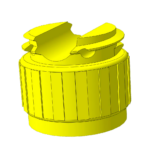Classification. History of closing means development
An important role in the manufacture of some products for storing things such as liquids is played out by closing means. These special units are responsible for safely packaging products.
Corking and capping means classification occurs by various criteria. Conditionally, it can be presented as follows:
1) purpose and frequency use rates: normal (repeated use) and branded;
2) material: metal (tin, aluminium, Crown corks, caps and bottle tops), polymeric, wooden, traditional cork, combined, etc.;
3) way of opening: pressing and turn; compression and turn; pressing and lift; turn; pre-releasing (for a catch);
4) method of fixing on a neck: corks, covers, combined. Covers close a filling opening on external circumference; corks are pressed or screwed on a container neck. Types of covers are the Bushona screw on threads, and capsules applied to closing flasks and bottles.
5) structural elements: fixing on a neck, consolidations, openings of packaging, functional purpose protecting from accidental opening.
Normal closing means can be reused, without any irreversible changes in packing. Opening of branded packaging leads to irreversible change (destruction) of packing. Branded, original closing means are intended for single use.
A closing mean can be fixed with the help of single pass and the multiple carvings; elastic elements; bayonet connections; welding or pasting; coupling rings, carbine, wedge and lever locks. The aforementioned listed methods are often combined.
Production of closing means also came about due to the development of advances in engineering, the emergence of new materials, technologies and innovations. Closing means for beer is a great example. The first beer corks (caps) appeared in the 17th and 18th centuries when humanity mastered the production of a glass container. Beer demanded special conditions of transportation as the drink continued its fermentation process, emitted carbon dioxide and sought to push out the cork holding it. Rubber and ceramic corks popular in those days did not fit. The first spoiled taste, the second did not remain in a bottle´s neck. Therefore, the beer cork which was manually cut out from Spanish or Algerian oak bark was invented. Interacting with liquid, the cork expanded and densely blocked a neck, creating an almost watertight seal. It became possible to store and transport beer within several days. For reliability, a cork and a bottle´s neck were additionally covered with a sealing wax or wax layer. The grades of beer which needed bigger endurance were closed by the cork strengthened by means of a special wire frame (similar to wine-making technologies).
Such cork was replaced by a Crown Cork invented by the American William Painter. The new cover was disposable, cheap and easy to use. It was made from steel varnished on two sides. The crimped flange edge resembled a crown and tightly adhered to an outer surface of a neck, providing sealed bottle closing. The internal surface of a Crown-cover was covered by the thin cork or paper layer protecting a metal bottom from contact with liquid. Crown corks were a successful invention and gradually started to be used not only for beer but also for closing of carbonated drinks, gaining in popularity at that time, and the principle of tightness assurance used by William Painter has not undergone major changes up to the present day.
Standards for bottle caps have increased nowadays. Their purpose is not only to provide a sealed closure, but also to be hypoallergenic and non-toxic. It is also important for caps to be easily opened and use, cheap to produce, convenient to transport, and have an aesthetic appearance.
Several sub-types of caps appeared during evolution. One of the most well-known is the fixed cap on a bottle´s neck which were prised off with a bottle opener. These were subsequently replaced with twist off caps which had grooves on the inside and knurled ridges on the outer edge, which allows a bottle to be opened without using an opener and are repeatedly able to close.
Crown-covers made of aluminium are also in high demand. This soft material is crumpled without any effort therefore the opener is also not required. The next invention is the ring-pull cork, which differs from its predecessors by the existence of a convenient ring for ease of opening.
Caps for PET appeared after the appearance of plastic containers. They are lids which screw on the neck of PET-bottles and jars which can be used for a long time. Originally, plastic caps were made from uniform plastic. Two-component caps appeared later (with an additional internal layer made from the polyliner). It is better at keeping carbon dioxide inside a bottle, and protects a neck from deformation during transportation. Plastic caps became more reliable after the advent of a plastic ring which is put on the neck of a bottle and affixed to a cover.
All listed advantages of plastic caps directly depend on the quality of plastic they are made from. Good food plastic is inert, is easily resistant to environment changes, and resistant to deformation. It does not rust and does not alter taste.
Development concerned not only beer closing caps. Therefore, the introduction of the lids for jars designed to conserve things with a screw top began. For GKR containers (glass canning rounding, I type) lids with a rubber sealing ring are made. In the process of folding, the roller of the closing machine bends the edges of a lid over, the rubber ring is squashed to provide sealing of a jar. The GKR container is tightly closed, however it is difficult to open such jars. The glass container of the II type (blooming) is closed by tin lids which are pressed to form a vacuum which is created in the sterilised jars after cooling. Sealing is provided due to putting condensing paste on a cover. This way is widely applied outside Russia, namely “Evrokan”, and it characterised by easy of opening and excellent sealing properties.
The German system of closing “PANNO” is a new invention. The cover is made from aluminium, and consolidation is made from polyvinylchloride. The neck of the jars have a double-thread cutting. Aluminium covers are not carved and perfectly adapt to roughness of a neck. The screw thread of glass during closing is pressed into the vertical position of a cover. The main disadvantage with this method is the high cost of aluminium covers (they are much more expensive than tin lids).


